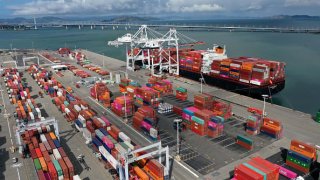
- The United States saw at least $1.3 billion in potential agricultural exports rejected at major ports on the East and West coasts, from July to December last year, according to a CNBC analysis.
- The rejections were particularly heavy in December, according to analysis of data compiled from the Census Bureau and the Ports of Los Angeles and Long Beach in California, and the Port of New York in New Jersey.
- This investigation comes at a time where China's exports hit records. The full year trade surplus reached $535 billion, the highest since 2015.
The United States saw at least $1.3 billion in potential agricultural exports rejected at major ports on the East and West coasts, from July to December last year, according to a CNBC analysis.
The rejections were particularly heavy in December, according to analysis of data compiled from the Census Bureau and the Ports of Los Angeles and Long Beach in California, and the Port of New York in New Jersey.
The estimated total value of lost export trade from the three ports for December was a minimum of $257.5 million. The Port of New York and New Jersey saw its largest volume of export rejections for 2020 during December.
Get San Diego local news, weather forecasts, sports and lifestyle stories to your inbox. Sign up for NBC San Diego newsletters.
The maritime carriers' export decisions at these ports are under investigation by the Federal Maritime Commission. Commissioners are examining whether this denial of trade is in violation of the 1984 Shipping Act. This investigation comes at a time where China's exports hit records. The full year trade surplus reached $535 billion, the highest since 2015.
One of the key legal obligations in the Shipping Act is the nondiscriminatory regulatory process by the carriers for the movement of goods by water. Maritime carriers have been favoring sending back empty containers to China in an effort to quickly fill the boxes so they can be transported along the more lucrative China-U.S. route.
Money Report
According to the Freightos Baltic Index, carriers are charging $5,548 a container to the East Coast, and $4,571 to the West Coast. U.S. agricultural export containers take longer to process because the product needs to be unloaded and the container needs to be cleaned. The route from the U.S. to China is also a fraction of the price ($715 a container), so carriers can afford to return empties instead of containers full of agriculture.
"Carrier practices are not only inflicting significant financial damage to U.S. exporters and importers, but are extremely short-sighted," said Peter Friedmann, executive director of the Agriculture Transportation Coalition. "Those practices are causing U.S. exporters to lose foreign customers, and setting the stage for the ocean carriers themselves to lose significant business in the future."
In December, shippers rejected an estimated 72,508 containers known as 20-foot equivalent units, or TEUs, according to CNBC's data anlysis. That tally was calculated by taking the difference between the actual empty exports in 2020 versus the 2019 share of export empties. The difference represents the amount of empty container exports that should have been filled in 2020.
From July through December, a total of 370,505 TEUs were denied out of the ports of Los Angeles, Long Beach, and New York and New Jersey, with a container deficit value of $1.3 billion.
To calculate the minimal value in the potential lost trade as a result of the rejection of agricultural exports, CNBC used the Port of Los Angeles' containerized agricultural export price for soybeans/oilseeds/grains, which can be found on the U.S. Census, USA Trade Online site. The value of this export is $3,552 a TEU. It is one of the lower valued exports.
China and Brazil
Starting in the new year, China traditionally starts buying from the United States' top soybean competitor, Brazil. The Agriculture Transportation Coalition's Friedmann says this rejection of trade can only provide more opportunity for Brazil.
"Brazil expanded its soybean production during the trade war and this denial of trade can only help them at the expense of the U.S. farmer," said Friedmann. "When foreign customers are denied affordable/dependable U.S. ag exports by carrier practices, they find alternative sourcing to U.S. agriculture, and simply do not return to their U.S. sources."
Friedmann said Asian buyers are frustrated. One of the largest soybean buyers in Asia is looking to switch delivery of U.S. soybeans from container to bulk freight, which can impact American jobs.
"Major China animal feed importers of U.S. soybeans are fed up with ocean carrier practices, charges and the dependably of container delivery," Friedmann explained. "Once these Chinese customers switch, they may never come back to the container model and that impact jobs at the port. Container ships generate more man-hours. This will mean many fewer containers to be loaded at our marine terminals, less work for longshoremen and fewer containers to be carried on container vessels, for years to come."
The decrease in U.S. exports can also be tracked in the global containerized trade data by local and global transport and logistics research company MDS Transmodal, China's share of global exports increased in the third and fourth quarters of 2020. North America's global export share however, never recovered.
"The increase in global trade was mainly driven by China, which has not only retained the title of 'factory of the world' but improved its position," explained Antonella Teodoro, Senior Consultant at MDST.
Other ports and next steps
The Northwest Seaport Alliance, the fourth-largest container gateway in North America, comprised of the Port of Seattle and Port of Tacoma, tells CNBC it also suffered a large loss in exports. In 2019, the ports moved out 913,332 containers of full exports. In 2020, that number dropped to 790,620 containers.
"Our exporters are suffering," said John Wolfe, chief executive officer of The Northwest Seaport Alliance. "We have spoken with our terminal operators and carriers about this issue and there is more work to be done by all in order to address the extreme challenges faced by our export community."
CNBC sent its findings to FMC Commissioner Louis Sola.
"I can say for a fact that some carriers have decreased their exports in return for empties (mainly the European lines) while other have made a conscious effort to pick up the slack and increases their exports in 2020 (mostly the Asian lines)," said Sola. "I do find this most interesting and warrant that it requires further discussion."
Sola said he is also keeping an eye on the potential jobs impact.
"This assertion warrants review. We support our longshore workers. Indeed, that is why I have attempted to draw attention to the loss of work generated by the cessation of cruises to our cruise ports across the nation and speak out for the safe resumption of cruising," he said.
The imbalance of trade has created an outpouring of letters by American exporters pleading for intervention by the Federal Maritime Commission. Letters have also been sent by politicians on both sides of the aisle. FMC Commissioner Rebecca Dye is currently leading an investigation into the carrier's actions in a Fact Finding 29 investigation.
The investigation was authorized in March 2020, and was expanded in November to include the container return and container availability for U.S. export cargo, as well as the charges in storage and late fees carriers are charging exporters.
"No public servant enjoys a trade deficit unless it is the other fellow's deficit," said Sola. "America is best served when we ship more product out than we ship in."






